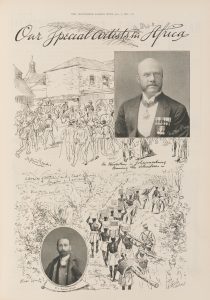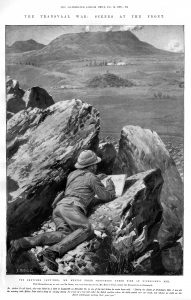Melton Prior (1845-1910)
Celebrated for his ‘boundless energy and resource’ by the Illustrated London News, the periodical with which his name become synonymous, Melton Prior embarked upon the ‘hazardous but fascinating life’ of a Special Artist in 1868. The son of a draughtsman, he was confined to illustrating domestic events for five years, before earning his first overseas assignment to West Africa in 1873, when he covered Sir Garnet Wolseley’s Ashanti Campaign. Travelling alongside George A Henty, from the Standard, and Henry Morton Stanley, the African explorer, working for the New York Herald, Prior threw himself into the role of the fearless war artist – making it the defining characteristic of his professional career. From then on barely a year went by without him ‘seeing service in the field’ and he gained legendary status for being ‘a man who has seen more of active service with armies in every quarter of the globe than any war artist or correspondent, or, indeed, any solder of his age.’ (Henry S Pearse, The Sketch, 15 February 1893, p. 145)

‘Our Special Artists in Africa’, Illustrated London News, 1 February 1896, p. 137, CAP00497
© National Portrait Gallery, London
Keen to advertise Prior’s coverage of the failed Jameson Raid early in 1896, and to signal his authority for doing so, the Illustrated London News would use as a front-page image this photograph of the assured and much decorated war artist inset against a reminder of his reportage of an earlier incident in Johannesburg – a sign of the high profile status enjoyed by Prior and H.C. Seppings (the other artist similarly featured in the illustration). Prodigious in terms of output, Prior would justify his noted reputation for travelling ‘luxuriously’ by the need to meet the huge demand for imagery, with the periodical sometimes publishing ‘as many as twenty-one of my sketches in a week’. He acknowledged the irony that he had been ‘the only man with a tent at Ulundi’ while the general ‘slept under a tarpaulin’, but countered ‘If I had not proper means of conveyance, servants to look after all my baggage, and an ample commissariat, how could I get through the work I do?’ (Pearse, p. 148)

Boer War Reporting. Engraving by Samuel Begg. War correspondent Melton Prior making sketches of the fighting at Nicholson’s Nek. Published in the Illustrated London News, 30 October 1899. © IllustratedLondonNewsLtd / MaryEvans
Prior did not cut a dashing figure in society, with the caricaturist Harry Furniss describing him as the ‘energetic, businesslike artist, with tremendous vitality and a terribly shrill laugh’ that had earned him, along with his large bald head, the nickname of the ‘”screeching billiard ball”’ (My Bohemian Days, 1919, pp. 127-8). Nonetheless, he was widely admired for his exceptional bravery and forbearance in the field. Images such as this one, which appeared in the Illustrated London News during his reportage of the Second Anglo-Boer War in 1899, that showed Prior sketching while under fire in the Transvaal, fuelled his heroic reputation: particularly in this case, as the soldier, ‘the late Dr Stark’, whose sketch of the war artist in action during the engagement at Nicholson’s Nek had provided the basis for the illustration, had perished shortly afterwards ‘killed by a shell at Ladysmith’. By noting the poignant circumstances involved in the production of the image, the Illustrated London News underscored the real danger in which their artist worked.